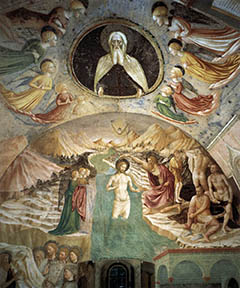
ADOPTIANISM. As the theological doctrine of the Logos which bulks so largely in the writings of the apologists of the 2nd century came to the front, the trinitarian problem became acute. The necessity of a constant protest against polytheism led to a tenacious insistence on the divine unity, and the task was to reconcile this unity with the deity of Jesus Christ. Some thinkers fell back on the “modalistic” solution which regards “Father” and “Son” as two aspects of the same subject, but a simpler and more popular method was the “adoptionist” or humanitarian. Basing their views on the synoptic Gospels, and tracing descent from the obscure sect of the Alogi, the Adoptianists under Theodotus of Byzantium tried to found a school at Rome c. 185, asserting that Jesus was a man, filled with the Holy Spirit’s inspiration from his baptism; and sa attaining such a perfection of holiness that he was adopted by God and exalted to divine dignity. Theodotus was excommunicated by the bishop of Rome, Victor, c. 195, but his followers lived on under a younger teacher of the same name and under Artemon. while in the Fast similar views were expounded by Beryllus of Bostra and Paul of Samosata, who undoubtedly influenced Lucian of Antioch and his school, including Arius and, later, Nestorius. There is thus a traceable historical connexion between the early adoptian controversy and the struggle in Spain at the end of the 8th century, to which that name is usually given. It was indeed only a renewal, under new conditions, of the conflict between two types of thought, the rational and the mystical, the school of Antioch and that of Alexandria. The writings of Theodore of Mopsuestia had become well known in the West, especially since the strife over the “three chapters” (544-553), and the opposition of Islam also partly determined the form of men’s views on the doctrine of Christ’s person. We must further remember the dyophysitism which had been sanctioned at the council of Chalcedon. About 780 Ehpandus (b. 718), archbishop of Toledo, revived and vehemently defended the expression Christus Filius Dei adoptivus, and was aided by his much more gifted friend Felix, bishop of Urgella. They held that the duality of natutes implied a distinction between two modes of sonship in Christ---the natural or proper, and the adoptive. In support of their views they appealed to scripture and to the Western Fathers, who had used the term “adoption” as synonymous with “assumption” in the orthodox sense; and especially to Christ’s fraternal relation to Christians—the brother of God’s adopted sons. Christ, the firstborn among many brethren, had a natural birth at Bethlehem and also a spiritual birth begun at his baptism and consummated at his resurrection. Thus they did not teach a dual personality, nor the old Antiochene view that Christ’s divine exaltation was due to his sinless virtue; they were less concerned with old disputes than with the problem as the Chalcedon decision had left it—the relation of Christ’s one personality to his two natures.
Felix introduced adoptian views into that part of Spain which belonged to the Franks, and Charlemagne thought it necessary to assemble a synod at Regensburg (Ratisbon), in 792, before which the bishop was summoned to explain and justify the new doctrine. Instead of this he renounced it, and confirmed his renunciation by a solemn oath to Pope Adrian, to whom the synod sent him. The recantation was probably insincere, for on returning to his diocese he taught adoptianism as before. Another synod was held at Frankfort in 794, by which the new doctrine was again formally condemned, though neither Felix nor any of his followers appeared.
In this synod Alcuin of York took part. A friendly letter from Alcuin, and a controversial pamphlet, to which Felix replied, were followed by the sending of several commissions of clergy to Spain to endeavour to put down the heresy. Archbishop Leidrad (d. 816) of Lyons, being on one of these commissions, persuaded Felix to appear before a synod at Aix-la-Chapelle in 799. There, after six days’ disputing with Alcuin, he again recanted his heresy. The rest of his life was spent under the supervision of the archbishop at Lyons, where he died in 816. Elipapdus, secure in his see at Toledo, never swerved from the adoptian views, which, however, were almost universally abandoned after the two leaders died. In the scholastic discussions of the 12th century the question came to the front again, for the doctrine as framed by Alcuin was not universally accepted. Thus both Abelard and Peter Lombard, in the interest of the immutability of the divine substance (holding that God could not “become’, anything), gravitated towards a Nestorian position. The great opponent of their Christology, which was known as Nihilianism, was the German scholar Gerhoch, who, for his bold assertion of the perfect interpenetration of deity and humanity in Christ, was accused of Eutychianism. The proposition Deus non factus est aliquid secundum quod est homo was condemned by a synod of Tours in 1163 and again by the Lateran synod of 1179, but Adoptianism continued all through the middle ages to be a source of theological dispute.
See A. Harnack, Hist. of Dogma, esp. vol. v. pp. 279-292; R. Ottley, The Doctrine of the Incarnation, vol. i. p. 228 ff, vol. ii. pp. 151-161; Herzog-Hauck, Realenclyk., art. “Adoptianismus.”
*******
Source: 1911 encyclopedia.
Copyright © World Spirituality · All Rights Reserved